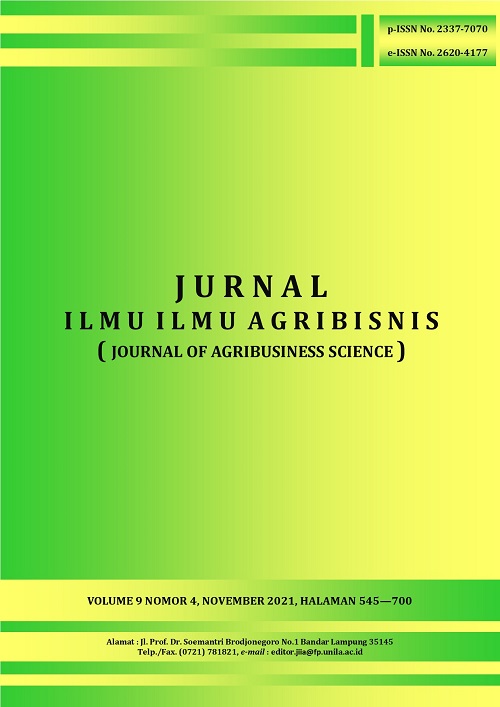EFEKTIVITAS PROGRAM RASTRA DAN PROGRAM BPNT TERHADAP TINGKAT PENDAPATAN DAN KESEJAHTERAAN KELUARGA PENERIMA MANFAAT DI KELURAHAN YUKUM JAYA KECAMATAN TERBANGGI BESAR KABUPATEN LAMPUNG TENGAH
DOI:
https://doi.org/10.23960/jiia.v9i4.5404 Abstract View: 328
Abstract View: 328
Abstract
This research aimed to determine the implementation, analyze the effectiveness of the implementation, the welfare and income of beneficiaries, the relationship between effectiveness of Rastra and BPNT in addition to the level of income and welfare of beneficiary families in Yukum Jaya Village. The research was conducted by survey method, include location was determined purposively of Yukum Jaya Village. The data was analized qualitative, effectiveness analysis methods, household income, welfare according to the BKKBN and Rank Spearman test. The results showed that the distribution of Rastra and BPNT has not fully complied with the regulations set by Ministry of Social Affairs. The effectiveness of Rastra and BPNT was not effective. The highest average income of Rastra was earned by 7 entrepreneurs in which average income month was Rp5,842,105 and the lowest income was earned by a laundry worker and clothes iron Rp378,947. The highest income of BPNT was earned by 10 vegetables trader with an average income/month of Rp6,659,032 and the lowest income was a tofu trader with an average income/month of Rp587,097. The welfare level of the respondents Rastra was in the stage of prosperous family II (KS II) and prosperous family III (KS III) of BPNT was classified on prosperous family stage III (KS III). There was no positive relationship between the effectiveness of Rastra and BPNT program and the level of income and welfare of beneficiary families.
Key words: BPNT, effectiveness, income, Rastra, welfare
Downloads
Downloads
Published
How to Cite
Issue
Section
License
Authors who publish with this journal agree to the following terms:
Authors retain copyright and grant the journal right of first publication with the work simultaneously licensed under a Creative Commons Attribution License that allows others to share the work with an acknowledgement of the work's authorship and initial publication in this journal.
Authors are able to enter into separate, additional contractual arrangements for the non-exclusive distribution of the journal's published version of the work (e.g., post it to an institutional repository or publish it in a book), with an acknowledgement of its initial publication in this journal.
Authors are permitted and encouraged to post their work online (e.g., in institutional repositories or on their website) prior to and during the submission process, as it can lead to productive exchanges, as well as earlier and greater citation of published work (See The Effect of Open Access).














